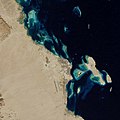File:Establishing El Gouna (2014).jpeg

Size of this preview: 600 × 600 pixels. Other resolutions: 240 × 240 pixels | 480 × 480 pixels | 768 × 768 pixels | 1,024 × 1,024 pixels | 1,362 × 1,362 pixels.
Original file (1,362 × 1,362 pixels, file size: 622 KB, MIME type: image/jpeg)
File history
Click on a date/time to view the file as it appeared at that time.
| Date/Time | Thumbnail | Dimensions | User | Comment | |
|---|---|---|---|---|---|
| current | 05:34, 12 March 2021 |  | 1,362 × 1,362 (622 KB) | StellarHalo | {{Information |Description=In 1985, sand and coral dominated the Red Sea coast in an area about 30 kilometers (19 miles) northwest of Hurghada, Egypt. Aside from a lone road that ran along the coast, the desert landscape was largely untouched by human activity. Three decades later, development has radically reshaped the coastline. The construction of El Gouna, a resort town, began in 1989. Building proceeded in waves, with a small cluster of summer holiday homes eventually morphing into a ye... |
File usage
The following page uses this file:
Global file usage
The following other wikis use this file:
- Usage on en.wikipedia.org
- Usage on hy.wikipedia.org
- Usage on ro.wikipedia.org
- Usage on www.wikidata.org


